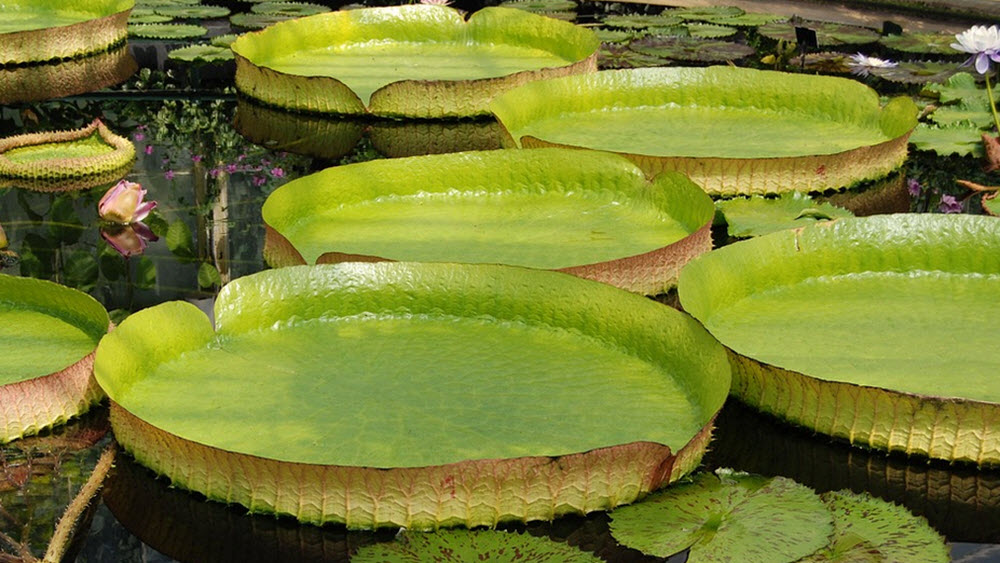Contents
The Goliath water lily, scientifically known as Victoria amazonica (previously Victoria regia), is one of the most spectacular aquatic plants, famous for its enormous floating leaves and stunning, fragrant flowers. It is the second-largest lily in the water lily family.
Native to the shallow waters of the Amazon River basin, this species belongs to the Nymphaeaceae family and is an example of the extraordinary biodiversity of tropical South America. Its remarkable characteristics have made it a subject of fascination and study in many parts of the world since the early 19th century.
The Goliath water lily stands as a symbol of the wonders of the natural world, embodying both the beauty and complexity of aquatic plant life. Its ecological significance, coupled with its impact on culture and engineering, underscores the profound influence that a single plant species can have across various domains.

Characteristics
Leaves: The most striking feature of the Goliath water lily is its massive leaves, which can grow up to 3 meters (nearly 10 feet) in diameter. These circular leaves float on the water’s surface, supported by a submerged stalk and a complex network of ribs and air chambers underneath, which give them buoyancy and strength. The leaf edges are turned up, forming a rim that helps keep water off the surface. The leaves are green on top and purplish-red beneath.
Flowers: The Goliath water lily blooms with equally impressive flowers that can reach up to 40 cm (16 inches) in diameter. The flowers are white when they first open at night and become pink or rose-colored on the second night. They emit a strong, sweet fragrance, attracting beetle pollinators. After pollination, the flower, and its stalk retract below the water surface, where the fruit develops.
Native environment
The native range for Victoria amazonica is Guyana in the Amazon Basin, in tropical South America. In the Inca (Quechua) language, it is named Atun sisac which means great flower.
The Goliath water lily is depicted on the Guyanese coat of arms.

Conservation
While not currently listed as endangered, the Goliath water lily faces threats from habitat destruction and pollution in its native environment.
Cultivation
In cultivation, this water lily requires warm temperatures and calm, shallow water. It is a popular feature in botanical gardens and greenhouses around the world, where its size and beauty continue to captivate visitors.
Ecology and pollination
The life cycle of the Victoria amazonica flower is an intriguing example of plant-insect interaction.
All the flowers of one particular plant will, on a given evening, be either all in the female phase or all in the male phase. This means that pollination must be with another plant.
he pollination is normaly carried out by a species of scarab beetle in the genus Cyclocephala. The flower generates heat through a process called thermogenesis, which helps disperse its fruity scent and attract pollinators. The flower’s temperature can rise above the ambient temperature, making it a cozy environment for its pollinators. When the flower opens, it is white, which furthers helps attract these beetles.
At nightfall, the flower closes with the beetles inside, and the beetles deposit pollen brought from other flowers. The next evening, the flower reopens, now colored pink and no longer fragrant, releasing the beetles to repeat the process. As the beetle emerges, it will push its way through the stames and become covered in pollen – which it can now bring to another flower or another plant.
Being trapped inside the flower is probably not a bad experience for the beetle, because the cavity in which it is kept contains a spongy, starchy tissue that provides nutrients for the insect.
Each plant will continue to produce flowers throughout the growing season. All the buds in a single patch will begin to open at the same time.
Protection from aquiatic herbivores
The stem and the underside of the leaves are protected by small spines. These spines can also crush rival plants nearby as the lily unfolds, making more rome for this big plant.
Early English cultivation
The Goliath water lily was named after Queen Victoria of the United Kingdom, reflecting the fascination and admiration it elicited during the Victorian era. Its discovery and introduction to Europe coincided with a wave of interest in greenhouse horticulture and the construction of large specialized glasshouses, such as the famous Palm House at the Royal Botanic Gardens, Kew.
The Duke of Devonshire and the Duke of Northumberland are two examples of notable gentleman gardeners who cultivated Goliath water lilies. In 1849, the engineer Joseph Paxton – working for the Duke of Devonshire – managed to grow the first Goliath water lily in England. It was not an easy task, since the climate in England is quite different from that of tropical South America, and Paxton had to use coal-fired broilers to keep the temperature up.
The water lily’s enormous leaves inspired Joseph Paxton in designing the Crystal Palace for the Great Exhibition of 1851 in London. Paxton, who had cultivated the plant at Chatsworth House, mimicked the leaf structure’s design to create a vast and light-filled glass and iron structure, showcasing the synergy between nature and engineering.